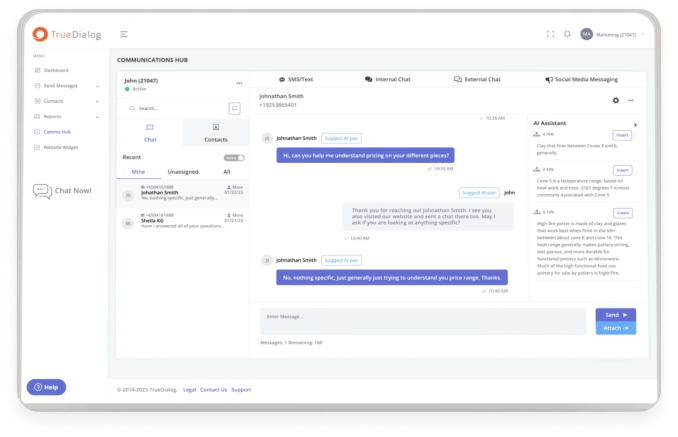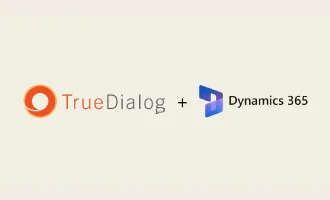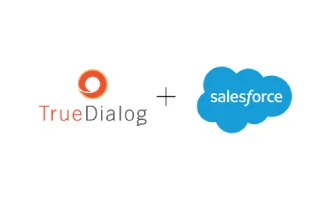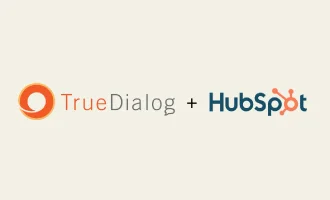Mass Texting Service to Reach Thousands Instantly
Drive Engagement at Scale with Bulk SMS
Instantly reach thousands with personalized, high-impact messages with mass text messaging. It’s a powerful tool for boosting engagement, driving action, and delivering time-sensitive updates—perfect for marketing, alerts, and communication at scale.
Request a Demo
Award Winning Functionality
Rated #1 in SMS Marketing for Bulk Campaigns by G2, TrueDialog’s SMS platform has superior features and functionality, offering higher delivery, higher throughput, and ease of use. With our ultra-reliable and highly effective platform, your campaigns perform better, driving meaningful engagement.
Enhance your workflow efficiency by integrating TrueDialog with your CRM. Automate Mass SMS campaigns through workflows, reducing human error and improving response times by making all conversations accessible to your team. Import contact lists with properties directly into your CRM for targeted messaging, while automatically logging interactions in the activity timeline for better customer insights. Set up recurring triggers to schedule SMS campaigns, ensuring consistent engagement without manual effort.
Launch campaigns instantly, with triggers, or schedule them for later. Easily clone existing campaigns for efficiency and consistency. Test, execute, and archive campaigns to streamline workflows and optimize engagement. Manage keywords for automated responses, track performance with link tracking, and use templates for quick deployment. TrueDialog ensures seamless, scalable messaging across multiple channels.
TrueDialog offers a variety of campaign types to fit your messaging needs. One-Way SMS delivers text messages of any length, while One-Way MMS allows you to include images. Send promotions via SMS or MMS. Engage users with customizable survey questions and responses. Two-Way campaigns enable automated replies. Reach customers via Email, Text & Email, or Voice, using text-to-speech for seamless communication. Use a variety of options to enhance engagement, automate communication, and optimize your messaging strategy.
TrueDialog centralizes SMS, email, voice, and social messaging for seamless communication, ensuring customer engagement across multiple channels. Combine long codes for personal interactions and short codes for high-volume messaging. Enhance outreach with voice broadcasting, adding a human touch to SMS updates. Integrate WhatsApp and Facebook Messenger to engage customers in real time. Use email for detailed communication, SMS for instant alerts, and a web chat widget for live website support.
TrueDialog’s proprietary link shortener enhances SMS deliverability, while our branded URLs boost engagement and click-through rates. Personalize messages with your own short URLs to track interactions, optimize campaigns, and improve analytics. Strengthen your brand presence while ensuring higher visibility and measurable results for every SMS campaign.
TrueDialog’s message templates simplify SMS creation with pre-written text and dynamic content for easy personalization. Quickly insert templates into messages to save time and ensure consistency. The Manage Templates page lets you create, update, and organize templates for streamlined communication. Access via our Comms Hub, templates enhance efficiency while maintaining a personalized touch for every customer interaction.
TrueDialog’s dynamic fields let you personalize messages with ease. Insert customer-specific details like first name to create more engaging, relevant interactions. Tailor each message at scale while maintaining a personal touch, enhancing response rates and customer satisfaction. Deliver targeted, high-impact communication effortlessly with TrueDialog’s dynamic messaging capabilities.
TrueDialog gives your team complete control over campaign delivery. Send messages manually, trigger them through workflows and customer journeys, or schedule them for a specific date and time. Automate recurring messages on a daily, weekly, or monthly basis to ensure consistent engagement. Use our proprietary “text-to-push” feature to choose your list and launch your campaign by text, available with user level access by phone number. Streamline your messaging strategy with powerful, flexible scheduling options.
TrueDialog’s Short Codes enable fast, reliable, and high-volume messaging with direct carrier connections for maximum deliverability. Ideal for promotions, alerts, and notifications, short codes boost brand recognition while ensuring your messages reach customers instantly. Scale your outreach effortlessly with this powerful messaging solution.
TrueDialog makes it easy to collect valuable customer feedback with customizable surveys and polls. Choose from Yes/No, Multiple Choice, Open Response, or Single-Use formats to gather insights efficiently. Automate responses and analyze results in real time to improve engagement and decision-making.



